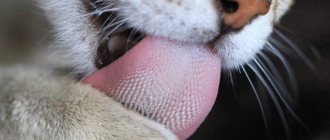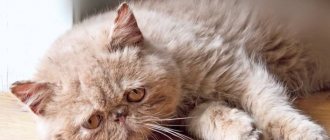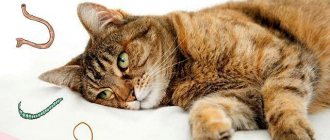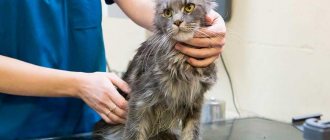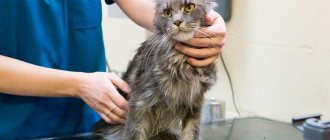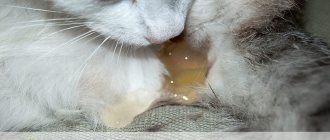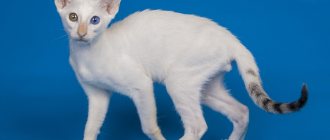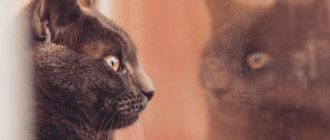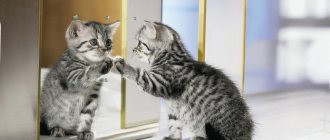Having noticed a small ulcer in the area of the upper or lower lip of his pet, the owner rarely attaches importance, believing that such a wound will go away on its own and will not cause harm to the body. If the wound is not large, formed on the skin near the lip or mucous membrane as a result of injury from rough food or during a fight with a relative, then it actually heals quickly over time and leaves no trace.
Even though the damage may seem minor, veterinarians recommend treating the affected area with a disinfectant solution to prevent bacterial infections.
In some cases, a sore seen on a cat's lip is a more serious injury caused by the herpes virus or a disease - eosinophilic granuloma. Failure to start treatment in a timely manner and incorrect diagnosis lead to serious changes.
Thus, the herpes virus greatly weakens the animal’s immunity and, against the background of primary infection, pathological conditions such as rhinotracheitis develop. This disease is characterized by constant mucus discharge from the nasal passages, sneezing and coughing. When sneezing, mucus from the nose and saliva from the mouth, infected with viruses, enter the eyes, which also leads to eye damage. Infected eyes constantly water, swelling develops, and crusts of dried exudate form.
The herpes virus almost constantly circulates in the animal’s body, being in “sleeping” mode. With a decrease in immune defense, violation of the rules of keeping and hygiene of the cat, poor quality feeding, the virus manifests itself, turning into an acute form. The owner’s task is to promptly identify pathological changes and contact a veterinary clinic for examination with qualified staff.
Gingivitis
Gingivitis is an inflammation of the gums in a cat; in the initial stages it occurs as a mild disease.
But if you start the process, then not only the superficial layers of gum tissue are affected, but also the deeper ones. Inflammation affects the ligaments that hold the animal’s teeth in the socket, causing them to fall out. Symptoms:
- Excessive salivation is the very first characteristic sign of the disease; drool is usually viscous and hangs in the form of “icicles”. It is easy to detect in the initial stages of gingivitis in cats and begin treatment on time.
- Swelling – puffiness is a fairly noticeable symptom; the gums begin to “hang” over the teeth.
- Redness – the gums may also have whitish spots or be bluish in color. Upon examination, there will be a bright red stripe on the gums near the base of the teeth. Normally, cats have pale pink oral mucosa.
- Bleeding can be independent and constant, or detected by pressure.
- Strong unpleasant odor from the mouth.
- Severe pain - the cat reacts aggressively to an attempt to examine the mouth, begins to refuse food, and loses weight.
- With ulcerative gingivitis, characteristic ulcers appear on the gums; due to pain, the cat may refuse not only food, but also water.
Treatment:
1. Remove tartar and brush your teeth regularly.
2. Treat the oral cavity with herbal decoctions (oak bark, chamomile) or antiseptic solutions (miramestine, chlorhexidine).
3. Lubricate the gums with dental ointments (Zubastic or Dentavedin).
4. In case of severe inflammation, the veterinarian can prescribe the cat the antimicrobial and antiseptic agent Metrogyl Denta (active ingredients metronidazole benzoate and chlorhexidine gluconate). 5. To speed up the healing of gums, use oil solutions of vitamins A and E, rosehip or sea buckthorn oils, ointments with actovegin or solcoseryl (these substances activate tissue regeneration processes).
===========================================================================================================================================================================================
What to do if your cat has a swollen lip?
If your cat has a swollen lip, it is best to consult your local veterinarian. As stated above, there are many reasons why cats can have swollen lips and it can be very painful and difficult to deal with. For the most accurate diagnosis and the most appropriate treatment, your cat will need professional help as soon as possible. Any delay will cause long-term unnecessary pain and discomfort. The biggest problem is that all of these causes of swollen lips may look very similar, but they all require different treatments, so expert judgment is needed to tell them apart and ensure the right care at the right time.
Home remedies are not suitable given the challenges in diagnosing and treating these problems. Diagnosis is not an easy task, and treatments are specific and can be quite intense depending on the cause of the problem. There are many home remedies available, but in most cases they are either useless or can cause serious harm to your cat, so they are not recommended. At best, they will delay your cat's recovery and thus unnecessarily increase pain. The best and fastest treatment comes after a correct diagnosis by a professional veterinarian.
The only home remedy that might be reasonable to use in some cases is to give the cat time - if you suspect that your cat has had an injury but is otherwise healthy and has slight swelling of the lips due to a cut or blow, then You can't let this fester. unreasonably. However, if your cat appears to be in pain or unwell, again, it is best to seek professional help early on. If your swollen lip doesn't go away within a few days, it's best to seek advice again - the situation may be more complicated than you think.
Article Author: Dr Joanna Woodnutt, (Veterinarian) Joanna is an experienced veterinarian based in the UK. She has written about pets and pet health for many pet websites, blogs and magazines and enjoys helping owners understand their pets through her writing.
Tartar
In fact, tartar is the same plaque, which is a colony of microorganisms that has only undergone calcification. It is quite strong and hard, has a brownish tint and is capable of growing.
Symptoms:
- Finding dark yellow or brown growths on your cat's teeth.
- The appearance of bad breath.
- Bleeding and inflammation of the gums.
- Soreness may appear, the cat may begin to eat poorly, or even lose its appetite.
Treatment:
1. Grinding of teeth with a special paste. Used at the initial stage of the disease.
2. Tartar removal: mechanical or ultrasonic.
============================================================================================================================================================================================
Symptomatic treatment
If there is any change in the color of the gums, you should take your pet to the vet. Many of the pathologies that are accompanied by a change in the color of visible mucous membranes are serious, some require long-term treatment or emergency care, and some can cause the death of a pet.
The veterinarian will help you correctly determine the cause of the color change and select adequate treatment. In some cases, an ultrasound, complete blood count, computed tomography or x-ray may be required for a more accurate diagnosis.
So, if a foreign body gets in and it is impossible to remove it mechanically, an emergency operation is performed.
For bites and allergic reactions, antihistamines are recommended. In case of poisoning, gastric lavage is effective.
In the case of pathologies of internal organs, the cause that caused the change in gum color is treated. Prescribe a therapeutic diet if necessary.
For diseases of the oral cavity, ointments, sprays and solutions of medications are prescribed. The cat's mouth is treated with cotton swabs.
Injuries are treated locally, decongestants and cold compresses are prescribed to the site of bruises.
Caries
The process of demineralization, accompanied by the destruction of the hard shell of the tooth and the formation of a cavity in its tissues, is called caries.
Caries occurs in several forms, which characterize the depth of damage to hard tissues:
- stage of a light spot (reverse development of the pathological process is possible for unknown reasons) - there are no changes in the structure of the tooth;
- superficial carious process - a dark pigment spot appears on the enamel, the enamel softens;
- with average carious lesions, enamel and dentin suffer;
- deep damage leads to complete damage to the tooth, affecting all its tissues, and attacks of acute pain are possible if hot or cold food comes into contact with the tooth; after the cessation of exposure to the temperature factor, the pain stops.
In the acute course of the pathological process, several teeth may be affected. In this case, the affected areas look like dirty gray spots.
Symptoms:
- decreased pet appetite;
- changes in the cat’s eating behavior (the animal may chew on one side or try to swallow food with minimal chewing movements);
- foul odor from the mouth;
- hypersalivation;
- change in color of the affected tooth;
- pain when chewing.
The cat cannot complain of pain, but will avoid any touching of the sore tooth.
Treatment:
1. At the initial stage, the veterinarian can use local antiseptics:
- silver nitrate;
- sodium fluoride.
2. If the damage is serious, the tooth is removed.
============================================================================================================================================================================================
general information
Anemia in cats is a fairly common disease, since the lifespan of their red blood cells is relatively short, about 70 days. Therefore, anemia can develop very quickly. Among other things, chronic diseases, frequent childbirth or infections can also affect the balance of hemoglobin in the blood plasma.
It is red blood cells that contain the substance hemoglobin, which contains iron enzymes that can transport and saturate the blood with oxygen. Therefore, a reduced amount of hemoglobin leads to weakness, dizziness, and loss of performance.
There are two types of disease: regenerative and non-regenerative. In the first case, the body itself tries to defeat the disease, trying to establish the missing number of red blood cells to replace the missing ones. In the second case, the bone marrow cannot produce a sufficient number of red blood cells due to some pathology. Anemia in a cat can develop in both types at the same time, which makes treatment very difficult.
Periodontal disease
Symptoms:
- Bad breath. One of the main reasons for visiting a veterinarian. The smell from the mouth becomes unbearable, putrid in nature, and can be felt from afar (when the animal enters the room).
- Decreased appetite. The cat wants to eat, but cannot. Refuses the once-favorite “crackers”, preferring soft food.
- Strange behavior. Owners notice how the pet shakes its head, rubs its muzzle with its paw, as if trying to get something out of its mouth. Sometimes you can clearly hear teeth grinding. The cat slurps when chewing. After eating, the lower jaw may tremble.
- Constant discharge from the mouth. A sick animal will drool profusely. Blood or pus may occasionally leak from the mouth. The fur on the chin is wet all the time, the skin becomes inflamed.
- Tartar and gum inflammation. If the cat is calm, you can move the upper lip and look into the mouth without opening its mouth. It is easy to notice yellow-brown tartar - massive hard deposits that sometimes completely cover the tooth itself. The gums are bright red or bluish in color and bleed. When pressed, a pus-like gray mass may come out from under it.
Treatment:
1. Hygienic cleaning of teeth from plaque and tartar at the initial stage of the disease. After this procedure, the crowns are coated with a fluoride-containing protective varnish. I treat the gums with antiseptic solutions and dental ointments (for example, Metrogil Denta).
2. Surgical intervention.
============================================================================================================================================================================================
Diagnosis of possible diseases
Diagnostic measures include an integrated approach. Suspecting the development of anemia in a cat, the doctor takes into account the clinical manifestations and also prescribes a number of laboratory tests. An obligatory point of diagnosis is the collection of anamnesis.
A blood test is performed to determine the processes occurring in the bloodstream, as well as to determine the possible development of inflammation. If a bone marrow dysfunction is suspected, a bone marrow puncture is prescribed. Based on the data obtained, the veterinarian prescribes therapy.
Types of CEG
Three types of skin lesions have been described in eosinophilic granuloma complex:
- An eosinophilic plaque is a hairless, flat, raised lesion that is often red, moist, and shiny. Plaques are most often found in the groin and armpits or on the outer thigh. These lesions are often itchy and cats may lick them constantly.
- Eosinophilic granuloma is a hairless, raised, often whitish-yellowish lesion on the skin or mouth, often with ulcers on the surface. Most often, granulomas are found on the back of the thighs (you can find the name “ linear granuloma ”), they can also occur in the oral cavity and on the tongue. Less commonly, other parts of the body (chin, paw pads, etc.) may be affected.
- An indolent ulcer is a well-defined defect (erosion or ulcer) on one or both upper lips. First, the lip swells, then an ulcer forms. The ulcer is usually painless and does not bleed.
